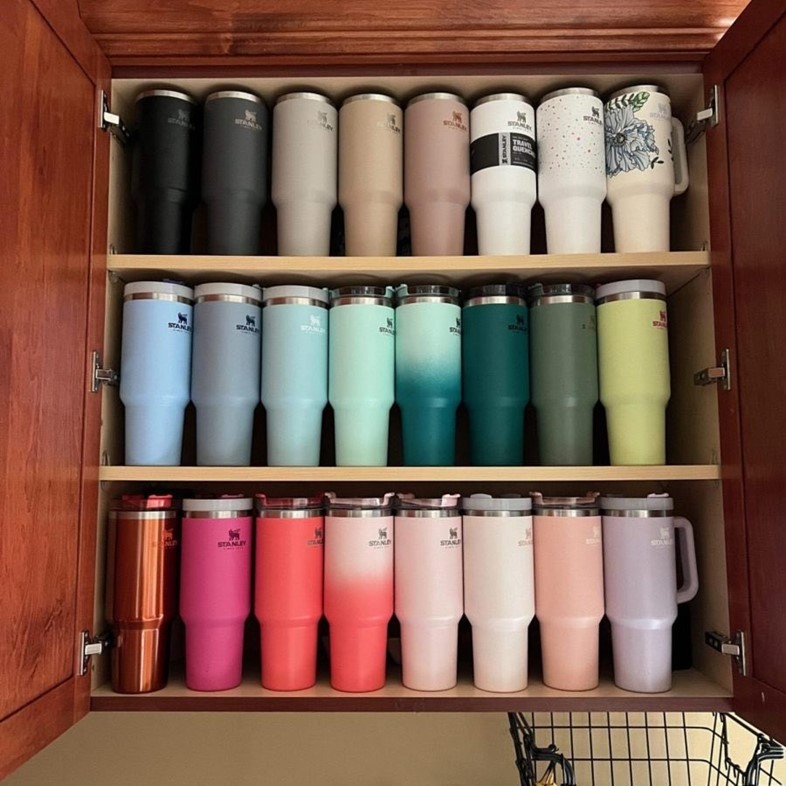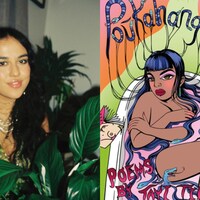#StanleyTumbler has over 1 billion views on TikTok, with Stanley raking in $750 million in revenue in 2023. How did these colourful cups become so coveted?
Destinee, 30, has a collection of five Stanley Quencher tumblers, all in different shades of pink. “I first got into Stanleys through my younger sister. She’s a big collector of Stanleys,” she says, explaining that her sister encouraged her to buy her first Stanley after spotting a metallic pink edition exclusively sold in Target. “I am a big pink lover,” Destinee explains.
When she saw the cup in person, it was love at first sight. “It was so beautiful, I loved it. So I picked it up and ever since then Stanley has been coming out with really beautiful pink colours that are Target exclusives,” she says. “I have picked up every single one, just because I feel like they’re so pretty. I needed to have them.” Destinee estimates she’s spent over $300 on her collection.
If that sounds excessive, it might disturb you to learn that Destinee’s collection is pretty tame compared to other Stanley collectors on TikTok. One creator, Emily Small, has 30 tumblers in different colours, from “rose quartz swirl” to “serene green” to “navy voyage”. Another creator named Carolina Kyung has over 100, with her multicoloured collection proudly displayed on acrylic shelves mounted on her wall. A third, Holly Snyder, claims to have 539. With 40oz Stanley Quencher tumblers priced roughly between $40 to $55, some of these collections are worth thousands.
The Stanley Quencher model wasn’t an instant hit when it was first released by the 111-year-old brand in 2016. It was only after the product was featured on The Buy Guide in 2017 that sales began to climb. Then the tumbler really blew up on TikTok, where the #StanleyTumbler hashtag has racked up over one billion views. Hype from creators and influencers continue to drive up sales, and in both 2022 and 2023 they were one of Gen Z’s most coveted Christmas gifts. The brand now regularly brings out Quenchers in new colour ranges for collectors to snap up; most recently, a video of women swarming around a display of the pink and red ‘Galentine’s Collection’ Stanley cups released at Target on New Year’s Eve went viral, and has since been viewed over 24 million times. With such fervent demand, it’s no surprise that the brand’s revenue has skyrocketed from $70 million in 2019 to $750 million in 2023.
To anyone who isn’t a Stanley stan, the cup’s popularity may seem baffling. Sure, it seems like a decent, reliable insulated cup – a woman recently went viral after posting a TikTok video where she appears to pull an intact tumbler, with ice still rattling inside, from the wreckage of a burnt out car. But how to explain the people who buy more than one cup – those rushing to Target to buy the same cup in a slightly different shade of red? Collectors claim their reasons for buying into the craze are simple. “I personally like collecting Stanleys just because it’s fun,” Destinee says. “I like to match them up with outfits. It’s so fun, being able to pick a different colour every day to match my personality or how I’m feeling.” Casey Lewis is a youth consumer trends analyst who writes the newsletter After School, and she agrees that the impetus driving consumers to buy Stanleys is, for the most part, surprisingly straightforward. “Buying stuff feels good – it’s a dopamine hit. There’s a thrill of satisfaction when you track down the colour or model or limited-edition drop,” she says. “But collecting anything, from Stanley tumblers to Vera Bradley purses to Snoopy plushies, also gives people a sense of purpose and accomplishment.”
@carolinakyung Updated tumbler wall #stanley #starbucks #tumbler ♬ original sound - Carolina Kyung
Lewis adds that she suspects so many people have started collecting Stanley Quenchers due to their (relatively) accessible price point. “Unlike collecting fine jewellery or designer purses, $40 Stanley tumblers are not cost-prohibitive for many people – obviously, given how many people own them!” It’s also likely that many collectors, who are predominantly young women, are yearning for a sense of community at a time when young people are experiencing record levels of loneliness (a header above an email marketing sign-up box on the Stanley website reads ‘join the Stanley community’). Buying into the trend can make consumers momentarily feel connected to other consumers of the same product, or as if they’re ‘participating’ in society.
The craze has sparked numerous discussions about hyperconsumerism and sustainability, partly because of the irony inherent in people hoarding reusable water bottles which are generally thought of as a more ‘sustainable’, one-off purchase. Destinee doesn’t see the issue. “I feel like everybody has something that they like to collect. I love collecting Stanleys just because it makes me happy. I know it’s not for everyone and that’s okay. Personally, I will continue to collect them,” she says. Lewis can also sympathise with Stanley collectors. “I think collecting anything that makes you happy is a worthwhile pursuit, whether it’s Happy Meal toys or stamps,” she says. “At least to a point.”
Because it’s impossible to ignore the fact that overconsumption is killing the planet. According to the Stanley website, the Quencher is constructed of “90 per cent recycled stainless steel for sustainable sipping”, but what good is a 90 per cent sustainable product if millions of them end up in landfill one day? And now that 10 million Quenchers have been sold globally, is it possible that overproduction could actually offset the brand’s attempts to be sustainable? Why is the Stanley tagline ‘#BuiltForLife’ – which implies you only need to buy one cup in your lifetime – when they routinely tempt back customers with limited edition colourways for them to buy?
@itsjennalu we gotta stop fighting over cups🫶🏼 #stanleytumbler #stanleycup #watertok #target #stanleytumbleraddiction #documentary #satire #comedy ♬ je te laisserai de mots - ☆☆
Lewis points out that unlike other products, at least Stanley cups are functional – “until you have five dozen of them anyway,” she caveats. “Because no one can possibly use that many water bottles.” According to researchers at MIT, a reusable bottle needs to be used 10 to 20 times before it has a lower environmental impact than a plastic bottle. And has someone like Holly Snyder really used all of her 539 bottles at least 20 times? It’s unlikely (and would take her 29 and a half years).
It’s difficult to heap all the blame on consumers, though. Stanley’s marketing campaign and the influencer-generated hype surrounding the Quencher is increasingly difficult to ignore, with pleasing images of Stanleys arranged in rainbow order appearing strangely soothing to our internet-addled minds. Plus, with rises in productivity outstripping rises in pay, many of us feel as though we’re working thanklessly; too much stick, too little carrot. Living costs are rising, making it harder and harder to accrue meaningful savings, so it’s little wonder that we’re looking to splurge on products like the Stanley cup for more immediate gratification. As Destinee says: “I feel like I work hard for my money, so I should be able to spend it on whatever I want.” She isn’t alone in feeling this way. In a capitalistic society driven by consumerism we can often feel as though our identities are entwined with our possessions, which is why many of us – not just Stanley collectors – often experience intense, almost unignorable feelings of ‘needing’ a certain item or product to feel content.
What else does the Stanley craze reveal about 21st century life? “That we’re all really, really thirsty? Just kidding,” Lewis says. Does it mean we’ve reached peak consumerism? “I do not think we’ve reached peak consumerism – unfortunately, I don’t think we're even close to reaching peak consumerism,” she surmises. “But I do think we’ve reached peak Stanley.”




